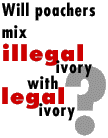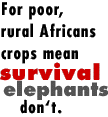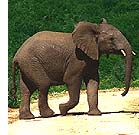

 |
|
The three African nations seeking permission to sell ivory answered this question with some of their own: Didn't a continuing ban punish them for success -- for having healthy elephant populations (while poaching continues to decimate herds in East Africa, elephants are flourishing in southern Africa). How should they deal with elephants that are destroying crops and threatening farmers? And shouldn't they be allowed to use their natural resources to raise money for strapped local economies?
Finally, if southern African elephants were not endangered, why should their ivory be treated as the product of an endangered species?
 The CITES plan allows the three countries to unload nearly 60 tons of stockpiled ivory once specified trade controls are in place. Advocates say the plan makes ecological and economic sense, since the stored ivory came from tusks that were confiscated from poachers, or from elephants that died naturally or were shot as rogues. The CITES plan allows the three countries to unload nearly 60 tons of stockpiled ivory once specified trade controls are in place. Advocates say the plan makes ecological and economic sense, since the stored ivory came from tusks that were confiscated from poachers, or from elephants that died naturally or were shot as rogues.
In making the hotly contested decision, CITES -- a United Nations convention -- had to balance the competing demands for economic development in poor African countries against the possibility that creating a market for ivory would unleash a new wave of poaching.
While the decision was a major endorsement for the concept of "sustainable utilization" of wildlife, CITES refused to go further by allowing sales of rhinoceros horn, another high-priced animal product that's caused devastation -- this time in a truly endangered species. Traffic/USA is a newsletter that tracks the international trade in wildlife and wildlife products.
Sustainable utilization is a clunky name for a radical change in conservation philosophy: from "protection and prohibition" to use-it-or-lose-it. "We'll only conserve biodiversity in the tropics if it's used, if it can provide incentives for conservation," says Jon Hutton of Africa Resources Trust, a Zimbabwe conservation and development organization. While rich countries can afford to set aside land for conservation, locking up wild things is a real disaster in much of the developing world, he argues. "In Zimbabwe, if wild land doesn't produce for people, it will be used for agriculture or cattle." For poor, rural Africans, he adds, "Crops give survival -- elephants don't."
End of story? Not.
|





 The CITES plan allows the three countries to unload nearly 60 tons of stockpiled ivory once specified trade controls are in place. Advocates say the plan makes ecological and economic sense, since the stored ivory came from tusks that were confiscated from poachers, or from elephants that died naturally or were shot as rogues.
The CITES plan allows the three countries to unload nearly 60 tons of stockpiled ivory once specified trade controls are in place. Advocates say the plan makes ecological and economic sense, since the stored ivory came from tusks that were confiscated from poachers, or from elephants that died naturally or were shot as rogues. 


